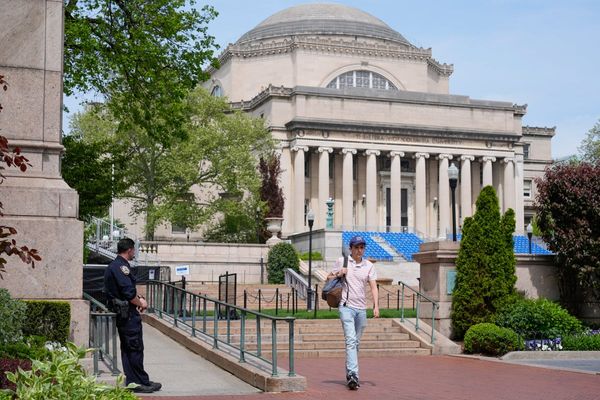
Lambs at Kentish Town City Farm
You may not necessarily associate central London with muddy-faced pigs and bleating lambs, but that’s exactly what you’ll find at Kentish Town City Farm. Sitting on a 1.5 hectare site alongside two railway lines, the farm – a 15-minute walk from Kentish Town train station – is a community charity that helps city folks connect with their natural environment. It’s home to sheep, goats, ducks, chickens, geese, three horses, two donkeys, two pigs and a cow, making it a veritable north-London Noah’s ark. In Spring 2018 the farm welcomed twin lambs, so here’s hoping for some more new arrivals this season.
Station: London Blackfriars to Kentish Town takes just over 10 minutes with Thameslink.
Hares in Malling Down
Early spring is the best time to catch a (sometimes blurry) glimpse of hares, which can whizz by at a whopping 40mph at full pelt. Fortunately, it’s also when the UK’s fastest land mammal swaps sprinting for boxing, meaning they can be spotted more easily in the shorter grasses. With its chalk grassland and scrub, Malling Down nature reserve in Sussex, about a 20-minute walk from Lewes railway station, is a fantastic place to observe these magnificent boxing spats (which actually take place between female hares who do it to spurn the advances of lusty male suitors).
Station: travel direct with Southern Railway to the historic market town of Lewes in just over an hour from London Victoria.

Bluebells in Heartwood Forest
At a sprawling 347 hectares, Heartwood – just under half an hour by bus from buzzy St Albans station – is the largest continuous new native forest in England, filled with more than half a million trees, pockets of ancient woodland and plenty of wildlife. Every spring, these pretty woodlands come alive with a carpet of vibrant bluebells (one fifth of the world’s bluebells actually grow here in the UK), filling the air with a heady fragrance and inviting bees, hoverflies and butterflies to feed. But it’s not all about what’s happening on the ground – keep your eyes on the trees and you’ll spot barn owls, tawny owls and kestrels peeking out of nest boxes too.
Station: you can reach St Albans in just 20 minutes from London St Pancras via Thameslink.
Elusive wildlife in the Cairngorms
The Cairngorms mountain range in the Scottish Highlands is one of the most dramatic in the country – a landscape of snow-cloaked peaks, glassy lochs and amber-coloured crags – which truly comes alive in springtime. As well as native woodland and Caledonian forest, it’s also home to myriad wild creatures (the park shelters 25% of Britain’s threatened species) including the elusive Scottish wildcat, which is rarer than the Bengal tiger, and incredibly difficult to spot. You might have more luck with some of the Cairngorms’ other wildlife, including red squirrels and pine martens in the woodlands, mighty osprey fishing in the lochs, red deer bellowing from the sedges and impressively stocky capercaillie birds, which strut around the forests. You can hole up in a hide and watch everything go by, or enlist the services of a guide on a nature tour. Either way, it’s a must-visit for adventurous nature-seekers.
Station: the Cairngorms are best accessed via train from Aviemore.
Tawny owls on Wimbledon common
It may be in the middle of an urban setting, but Wimbledon common – 20 minutes’ walk from Wimbledon station – is home to a surprising array of animals and birds (not to mention an army of litter-picking Wombles). You’ll find all sorts of mammals from grey squirrels to badgers (there are thought to be 17 badger setts on the common), but local volunteers have specifically been recording the number of birds here and estimate there to be up to 100 different species to see. Flick your eyes skywards for sightings of kestrels, sparrowhawks, hobby and common buzzards. But for something really special, take a walk around these fields at dusk. If you keep your eyes and ears peeled, you may hear the eerie hoot of tawny owls in the trees and, if you’re very lucky, see one hunting low over the grasses as the light drains from the sky.
Station: take Thameslink from London Blackfriars and get to Wimbledon in just over half an hour.

Wading birds on the Isle of Sheppey
Just off the Kent coast, surrounded by the waters of the Thames estuary, you’ll find Elmley – a mist-cloaked pocket of loveliness filled with wading birds, raptors and blankets of jewel-coloured wildflowers. Spring is a wonderfully evocative time here, when Lapwings swoop over the marshes (filling the air with their distinctive “peewit” calls) and 40 species of birds raise their young, including redshanks and grebes, which lead their chicks around the wetlands in single file. “Mad March” hares can be seen here too, and if you’re particularly beady-eyed, you can even spot fluffy leverets bumbling about in April. The entrance to the reserve is walkable – less than one mile from Swale station.
Station: take the train from London Victoria to Swale in just over an hour, changing at Sittingbourne.
Orchids in Marline Valley nature reserve
While most species of orchid are confined to the tropics, you’ll find many of the fantastical blooms here in the UK. The plants begin their growth spurts in spring and Hastings is home to a pick’n’mix of varieties including violet helleborines, green-winged orchids and bird’s nest varieties. Take a walk through Big Meadow in woody Marline Valley nature reserve, a 40-minute bus ride from Hastings station, and you’ll find common spotted orchids in abundance. Closer to the town centre is Hastings cemetery (get there in under 20 minutes by bus), where you’ll find a smattering of autumn lady’s tresses within the gravestones. Elsewhere, you’ll find two breeding pairs of peregrine falcons in the cliffs between Hastings and Pett Level. The birds are regularly seen swooping over the town, pestering the resident feral pigeons.
Station: travel from London Victoria to Hastings in just under two hours with Southern Railway.

Butterflies in Devonshire Road nature reserve
Nestled within the Forest Hill to New Cross Gate railway cutting, Devonshire Road nature reserve is perhaps the finest railside wildlife habitat in London (just a 10-minute walk from Forest Hill station). You’ll find all sorts of trees and plants here, including tangles of Old Man’s beard clematis (which fidgets with insects and birds), wild garlic, dog violets and many other flowers. Shrubs are regularly cut back to form glades for butterflies – including holly blue, comma, red admiral, peacock and brimstone – and, if you crane your neck backwards at dusk, you’ll see bats hunting for insects in the treetops.
Station: the Southern Railway service from London Bridge can get you to Forest Hill in just 15 minutes.
Red squirrels in Grasmere
Since the 1870s, the population of red squirrels in the UK has plummeted from around more than 3m to an estimated 120,000. But there are still pockets of the country in which these bushy-tailed creatures thrive. One such place is Allan Bank estate in Grasmere (once home of poet William Wordsworth), right in the heart of the Lake District. Accessible by bus from Windermere train station, the gardens here are home to many of the rare creatures, which forage for green acorns, nuts, seeds and pine cones among the trees. Binoculars are available in the study for keeping a close eye on the flighty creatures, and you can also stroll the garden paths, keeping your eyes peeled for a flash of fiery red in the branches.
Station: head to Windermere, which takes just over four hours from London by rail. From there the bus to Grasmere takes around 40 minutes.
Book direct at southernrailway.com and avoid any booking fees. Groups of three to nine people travelling at Off Peak or Super Off Peak times save a third on their train journey across Southern, Thameslink, Great Northern or Gatwick Express.







